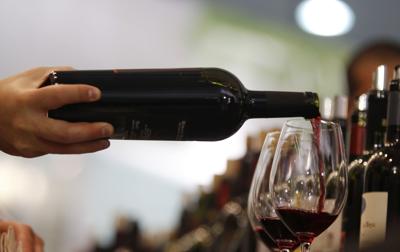Far northeastern Italy features some of the peninsula’s most spectacular scenery and most complex history. Yet it’s often a second thought for visitors, except for Venice and maybe Verona for Shakespeare fans and the Dolomites for skiers. Sadly, the same can be said for most of its wines. Here is my humble effort to correct that.
Northeast of Verona, the Alto Adige (also known as Südtirol — South Tyrol — because of historical Austrian and Germanic influences) is situated south of the Alps (bordering Switzerland and Austria). Distinguished for its high-altitude vineyards, the region is noteworthy mostly for distinctive white wines with bracing acidity and substantive character, but also for red wines of considerable interest. And don’t be surprised if you can detect that illusive quality of “minerality” that wine aficionados seek.
Many of those wines are German varieties, such as a bright, lively, floral, nutty, lightly spicy Müller-Thurgau (2016 Cantina Bolzano “Eisacktaler”, $20); a crisp, fruity, spicy Kerner (2017 Kurtatsch, $17); and a full-bodied, herbaceous, invigorating Sylvaner (2017 Abbazia di Novacella, $20).
Others are French varieties: amazingly refreshing and multifaceted pinot grigio unlike anything produced in America (2015 Pacherhof, $31), and delightfully honeyed, lively, rich pinot bianco (2015 St. Michael-Eppan “Schulthauser”, $21).
And there are several native varieties: wonderful lychee, apricot and spice of Gewürztraminer (2016 Cantina Terlano Estate Bottled, $27); floral, spicy and firm intensity of Moscato Giallo (2017 Alois Lageder “Vogelmaier”, $25); intense dark fruit, earthy pepper and firm tannins of Lagrein (2015 Cantina Bolzano Riserva “Taber”, $50); and the softly fruity and lively delicacy of Schiava — Vernatsch in German (2017 Castelfeder Alte Reben, $17).
Friuli-Venzia Giulia is Italy’s farthest northeast wine-producing region, bordered by Austria, Slovenia and the Adriatic. Many empires have claimed the area over the millennia, most notably the Republic of Venice for nearly 1,100 years from the seventh through the 18th centuries. Still, the area’s culture arguably has more in common with Austria and Slovenia than the rest of Italy.
Similar to the Alto-Adige, it has good wines from familiar grapes such as chardonnay and merlot. There also is a cornucopia of impressive regional varieties. The white wines are especially fine — somewhat higher alcohol and higher acidity, making for exquisite balance.
Located about 11/2 hours east of Venice in the important Collio subregion, the Marco Felluga winery is one of Friuli’s foremost representatives. Here, the watchword is balance — between tradition and innovation — as the winery was founded in the 1950s on a property dating back to the 1300s, while the Felluga family’s winemaking history back to the 1800s.
The 2016 Pinot Grigio “Mongris” ($18) fills the mouth with peach, melon and stone fruit accented with basil and ginger. The 2015 Bianco “Molamatta” ($26) is a fascinating blend of friulano, pinot bianco and ribolla gialla showing zippy apple, apricot, pineapple and lemon with fine weight and structure.
Another historical property, dating to the 13th century, Russiz Superiore was acquired by the Felluga family in 1967. Notable for estate vineyards surrounding the winery, the 2016 Cabernet Franc ($29) impresses with black fruits, herbs, smoky spice and soft tannin.
The 2018 Sauvignon ($29) is inspiring for its crisp lemon, peach and melon. Packed with flavor, it still drinks with finesse.








 Your Privacy Choices
Your Privacy Choices